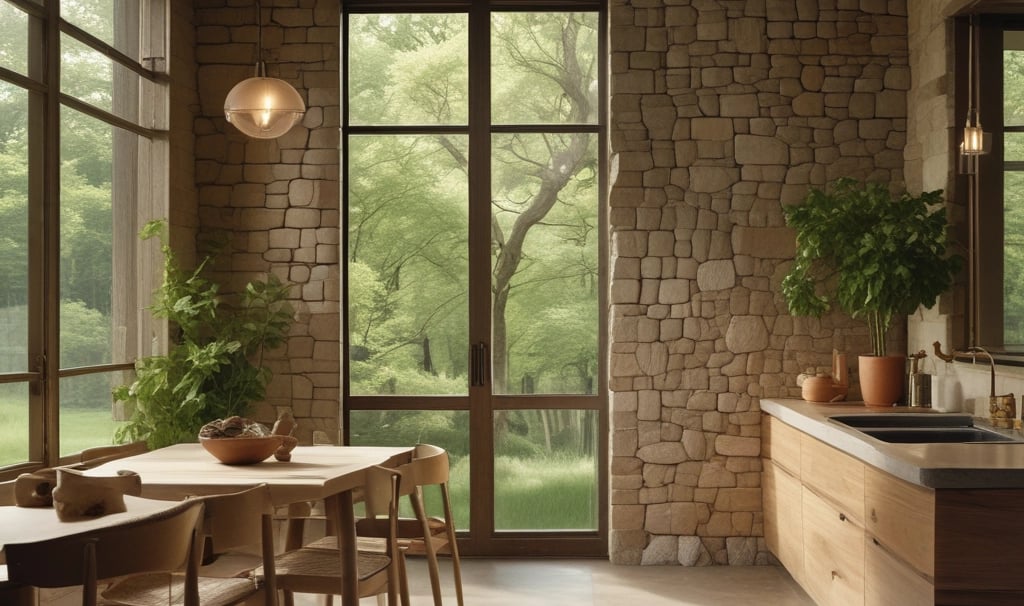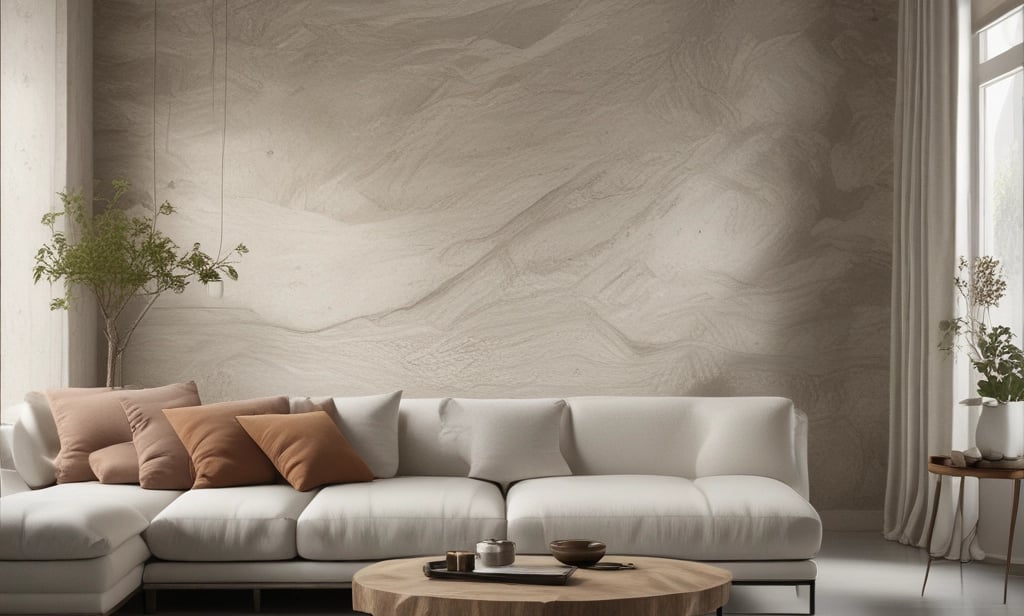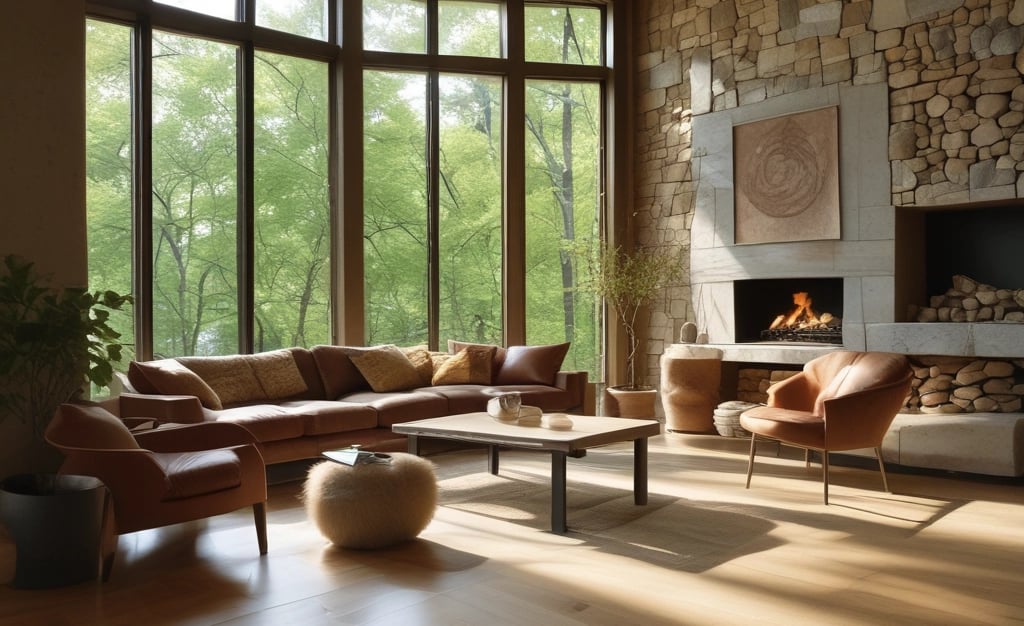Natural Materials and House Interior Design: Embracing Eco-Friendly Aesthetics
HOME DESIGN IDEAS
Mohamed Amine
10/20/20259 min read


Embracing Nature Indoors: The Essence of Organic Design
Organic design is a concept that revolves around the seamless integration of natural elements into interior spaces, creating an ambiance that promotes tranquility and harmony. By incorporating materials and features inspired by nature, this design philosophy emphasizes the importance of fostering a connection between inhabitants and their environment. Such an approach not only enhances the aesthetic appeal of a space but also influences the psychological well-being of its occupants.
One of the primary facets of organic design is the harnessing of natural light. Large windows, skylights, and open layouts allow sunlight to flood indoor areas, creating a warm, inviting atmosphere. Natural light has been shown to improve mood and productivity, reinforcing the notion that a well-lit space can lead to a healthier lifestyle. Furthermore, skillful manipulation of light and shadow can accentuate specific design elements, highlighting textures and colors that resonate with nature.
Incorporating plants into interior design serves as a cornerstone of organic aesthetics. Not only do plants purify the air, but they also bring vibrant life into a space, creating a soothing atmosphere conducive to relaxation. By selecting a variety of plants ranging from small succulents to large potted trees homeowners can establish an inviting indoor garden that fosters a continuous connection with the natural world.
Equally important is the use of a natural color palette. Earth tones, such as warm browns, soft greens, and muted blues, can evoke the feeling of being in nature. These colors, when applied strategically throughout a space, work in tandem with natural materials to create a cohesive environment that promotes peace and comfort. By opting for furnishings and decor that echo these hues, individuals can further enhance their interior spaces, cultivating an atmosphere that embodies serenity and organic beauty.
Sustainable Choices: Eco-Friendly Materials for Modern Homes
As the trend towards sustainable living continues to gain momentum, the choice of materials used in home interior design has become increasingly important. Eco-friendly materials not only contribute to a healthier environment but also enhance the aesthetic appeal of modern homes. Among the most popular sustainable choices are bamboo, rattan, and reclaimed wood. Each of these materials carries unique characteristics that make them suitable for contemporary interiors while promoting environmental awareness.
Bamboo is renowned for its rapid growth and renewability, making it one of the most sustainable materials available. This grass species grows significantly faster than traditional hardwoods, requiring less land and resources for cultivation. Its lightweight yet sturdy structure allows for versatile applications, from flooring to furniture and decorative accents. Additionally, bamboo's natural beauty suits a range of design styles, from minimalist to rustic, ensuring it can seamlessly integrate into any home.
Another sustainable option is rattan, a climbing palm that thrives in tropical environments. Rattan furniture, known for its durability and flexibility, has been a popular choice for both indoor and outdoor spaces. The appeal of rattan lies in its ability to blend comfort with elegance, providing an airy feel that is ideal for modern aesthetics. Sourcing rattan from ethical suppliers ensures that its use aligns with eco-friendly goals, supporting sustainable harvesting practices.
Reclaimed wood is a deeply appealing choice for those seeking to add character and warmth to their homes. This material is salvaged from old structures, such as barns, factories, and warehouses, which not only reduces waste but also contributes to preserving historical elements. The unique grain patterns and textures found in reclaimed wood can create stunning visual statements in flooring, cabinetry, and furniture pieces. To make the most of reclaimed wood, it is advisable to source from reputable vendors that prioritize sustainable practices.
In conclusion, embracing eco-friendly materials such as bamboo, rattan, and reclaimed wood in interior design allows homeowners to create stylish spaces that reflect a commitment to sustainability. Through careful sourcing and thoughtful application, these materials can transform modern homes into eco-conscious sanctuaries.
Stone, Clay, and Linen: The Beauty of Raw Textures
In contemporary interior design, the inclusion of natural materials such as stone, clay, and linen has become increasingly popular due to their tactile appeal and visual warmth. These raw textures offer a sense of groundedness and authenticity, establishing a profound connection between the indoors and the natural environment. By integrating these elements into home decor, designers can create spaces that exude comfort and sophistication.
Stone, as a foundational material, is celebrated for its durability and variety. From rustic slate to polished marble, the versatility of stone allows for numerous applications in interior settings. Whether used as accent walls, flooring, or countertops, stone can dramatically enhance the ambiance of a room. The unique patterns and colors found in natural stone ensure that each installation carries its distinct personality, promoting a timeless aesthetic that aligns with eco-friendly design principles.
Similarly, clay serves as a compelling material for various applications. Notably used in pottery and wall finishes, clay's textural qualities bring warmth and earthiness to interiors. Its natural variance in color and finish allows for creative freedom in both functional and decorative elements. Terracotta tiles, for instance, can be utilized in kitchens or bathrooms, providing an organic touch that is both practical and visually appealing.
Linen, renowned for its breathability and softness, offers a contrasting texture to the more rigid surfaces of stone and clay. This fabric is ideal for curtains, upholstery, and cushions, promoting comfort while seamlessly coordinating with other natural materials. Incorporating linen into a design scheme softens spaces, adding a layer of coziness and elegance.
Ultimately, combining stone, clay, and linen in interior design not only enhances the tactile and visual experience of a space but also aligns with sustainable practices. By thoughtfully selecting and incorporating these materials, individuals can create interiors that reflect eco-conscious values while celebrating the inherent beauty of raw textures.
Balancing Nature and Modernity: Creating a Cohesive Design
Creating a harmonious interior design that seamlessly blends natural materials with modern elements requires thoughtful consideration of various factors. One of the primary methods to achieve this balance is through the intentional mixing of textures. Natural materials such as wood, stone, and textiles possess distinct tactile qualities that can enliven a space when paired with sleek, contemporary finishes like metal or glass. Combining a rustic wooden table with minimalist metal chairs, for instance, can create a striking contrast while maintaining a unified aesthetic.
Color harmony also plays a crucial role in achieving a cohesive design. Utilizing a neutral palette can provide a backdrop that allows natural materials to shine without overwhelming the space. Earthy tones, such as beige, gray and soft greens, can be incorporated to reflect the beauty of the natural world while complementing modern design elements. Incorporating natural materials in statement pieces or accent features such as a stone fireplace or a wood accent wall can introduce warmth and texture, marrying the organic with the contemporary.
Purposeful placement of natural items within modern settings further enhances the visual cohesion of a design. Strategically positioning plants, for example, can introduce an element of nature that softens hard lines often found in contemporary furniture. Additionally, using natural materials in decorative accents, such as a handwoven rug or ceramic décor, maintains the focus on eco-friendly aesthetics while effortlessly blending with modern decor. By adhering to these principles, homeowners can create interiors that not only showcase the beauty of natural materials but also embrace the sleek elegance of modern design.
Eco-Friendly Furnishings: Selecting Sustainable Decor
When it comes to eco-friendly furnishings, the choice of materials and craftsmanship plays a crucial role in ensuring that your home maintains both aesthetic appeal and sustainability. Selecting sustainable decor can significantly reduce your environmental impact while enhancing the overall ambiance of your interiors. To begin this process, it is essential to identify brands that prioritize sustainability in their production methods. Look for companies that openly communicate their commitment to eco-friendly practices, such as using renewable resources, recycled materials, or upcycled goods.
One crucial aspect to consider is certification. Many sustainable furnishings come with certifications from recognized organizations that validate their eco-friendly claims. Certifications such as Forest Stewardship Council (FSC) for wood products, GreenGuard for low-emission materials, or the Global Organic Textile Standard (GOTS) for textiles can reassure you that your furnishings meet rigorous environmental standards. Understanding these certifications can help you make informed decisions, ensuring that the items you choose not only look good but also support sustainable practices.
Durability is another integral factor when selecting eco-friendly furnishings. Investing in quality pieces that are built to last not only reduces the frequency of replacements but also minimizes waste. Look for furniture crafted from robust materials like hardwood, metal, or durable natural fibers that can withstand the test of time. Moreover, consider local artisans who often provide handcrafted items that emphasize careful craftsmanship and local resource usage. This approach not only fosters creativity and unique design but also supports local economies while reducing the carbon footprint associated with long-distance shipping.
Ultimately, when you prioritize sustainable furnishings, you are making a conscious choice that enhances both your living space and the environment. By selecting brands that reflect eco-friendly values, researching certifications, and valuing durability, you can create a beautifully furnished and responsible interior.
Lighting Solutions: Harnessing Natural Illumination
Natural illumination plays a pivotal role in enhancing the aesthetic appeal of interiors that celebrate natural materials. The strategic incorporation of sunlight not only elevates the visual beauty of spaces but also promotes a sense of well-being among inhabitants. To maximize this precious resource, one should consider various architectural and design strategies that enable sunlight to flow freely into the home.
One effective approach to optimizing natural light is the placement and size of windows. Large, strategically positioned windows can significantly increase light intake, making rooms feel more expansive and inviting. Additionally, opting for skylights can introduce daylight into areas that may otherwise remain dim, such as hallways or inner rooms. This interplay between natural light and organic materials, such as wood or stone, can create a harmonious environment that fosters peace and relaxation.
When determining window treatments, it is essential to choose options that can regulate light while preserving the overall aesthetic. Lightweight, sheer fabrics allow daylight to filter through, creating a soft, diffused glow. On the other hand, materials like bamboo or linen, which are derived from natural sources, align well with eco-friendly designs. These choices resonate with natural aesthetics and contribute positively to interior ambiance.
Moreover, the integration of lighting fixtures can further enhance the effect of natural illumination. Selecting fixtures that mirror organic shapes or use sustainable materials adds another layer of cohesiveness to the overall design. Pendant lights made from rattan or wood, for example, not only illuminate spaces but also seamlessly blend with the inherent warmth of natural materials.
In conclusion, by harnessing natural illumination through thoughtful design choices, one can cultivate inviting interiors that harmoniously align with the principles of eco-friendly aesthetics. Embracing sunlight and natural materials fosters a living environment that is both beautiful and attuned to its surroundings.
Maintenance and Care: Sustaining Natural Materials
Maintaining natural materials in home interior design is essential for sustaining their beauty and longevity. Different types of natural materials, including wood, stone, and textiles, require specific care routines to prevent deterioration and ensure that they remain environmentally friendly. Understanding proper maintenance techniques can significantly contribute to the durability and aesthetic appeal of these materials.
For wooden surfaces, regular dusting with a soft cloth is crucial to prevent scratches. It is also important to use appropriate cleaning products that are gentle and pH-neutral, avoiding harsh chemicals that could strip the wood's natural oils. Periodic application of a suitable wood conditioner can enhance the material's luster while providing a protective barrier against moisture and dirt. To prevent wear and tear, consider placing coasters under beverages and rugs in high-traffic areas to minimize friction.
Stone materials, such as marble or granite, also necessitate particular attention. These surfaces should be cleaned with mild soap and warm water, avoiding acidic-based cleaners that can damage the finish. Sealing stone countertops annually can prevent stains and preserve their natural beauty. When dealing with natural stone floors, leveraging mats and area rugs can reduce scratches from foot traffic, promoting restoration and upkeep.
Natural fiber textiles like cotton, linen, and wool require gentle cleaning methods to maintain their strength and color. Washing these fabrics on a delicate cycle and air-drying when possible helps prevent shrinking and fading. To avert wear caused by sunlight, consider placing these textiles away from direct sunlight exposure or using UV-filtering window treatments. Regular fluffing and vacuuming can also keep upholstery looking its best.
By adhering to these maintenance techniques, homeowners can ensure that their natural materials will continue to exude charm and functionality. Embracing these eco-friendly aesthetics leads to sustainable living, as well-cared-for natural materials contribute to a healthier environment over time.
References
Natural Decorating: Sophisticated Simplicity With Natural Materials
Author: by Elizabeth Wilhide, Joanna Copestick, & 3 more
Link: Natural Decorating - (Natural Decorating)Naturally Modern: Creating Interiors with Wood, Leather, Stone, and Natural Fabrics
Author:by Andrew Wood
Link: Naturally Modern - (Naturally Modern)Modern Natural: Creating Sophisticated Interiors with Nature’s Materials
Author: by Ros Byam Shaw, Andrew Wood
Link: Modern Natural - (Modern Natural)The Home Zone: Making the Most of Your Living Space
Author: by Ros Byam Shaw , Leslie Geddes-Brown , Vinny Lee
Link: The Home Zone - (The Home Zone)




